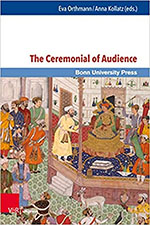For quite a long time now, highly interesting fields of research such as the early modern courtly audience, had been disregarded, being considered as a crucial part of classical diplomatic history and hence a flagship of antiquated and Eurocentric historiographical research. But thanks to the development of new theoretical approaches such as global history, postcolonial studies, and the ‘New Diplomatic History’, the courtly audience has emerged as an extremely fruitful field of research, as numerous publications in recent years have shown.[1] In addition to these new methodological approaches, more and more, especially younger, researchers and scholars are moving away from their classically Eurocentric historical scholarship, seeking to overcome their institutionally fixed trenches and to open up to transdisciplinary collaborations with smaller subjects of Area Studies, such as Islamic Studies, Japanese Studies and Tibetology. One exemplary result of such a fruitful interdisciplinary collaboration is the present edited volume, which even includes researchers of Ancient Oriental Studies and Byzantine Studies who study programmes which have been almost done to death in Europe.
The present volume is the result of a workshop held in June 2017 which was institutionally rooted at the Collaborative Research Center—Power and Domination: Premodern Configurations in a Transcultural Perspective at the University of Bonn. It contains an introduction and seven case studies that not only focus on intercultural diplomatic encounters but rather seek to approach courtly audiences as ceremonial staging and spaces of representation and interaction between rulers, elites, and populations of the respective ruling systems. The spectrum of audiences studied here ranges from courts in the Ancient Near East (Alexander Pruss), to Byzantine ceremonials in contact with European crusaders (Alexander Beihammer), to the Muscovite court in the 17th century (Dittmar Dahlmann), from the Ghaznavid emancipation vis-à-vis the caliphate (Eva Orthmann) to the Mughal court, which is treated in two contributions (Anna Kollatz on audience interaction and Ebba Koch on architectural framing). The volume finally makes an arc to the Ottoman court (Hedda Reindl-Kiel) and its positioning vis-à-vis foreign envoys.

